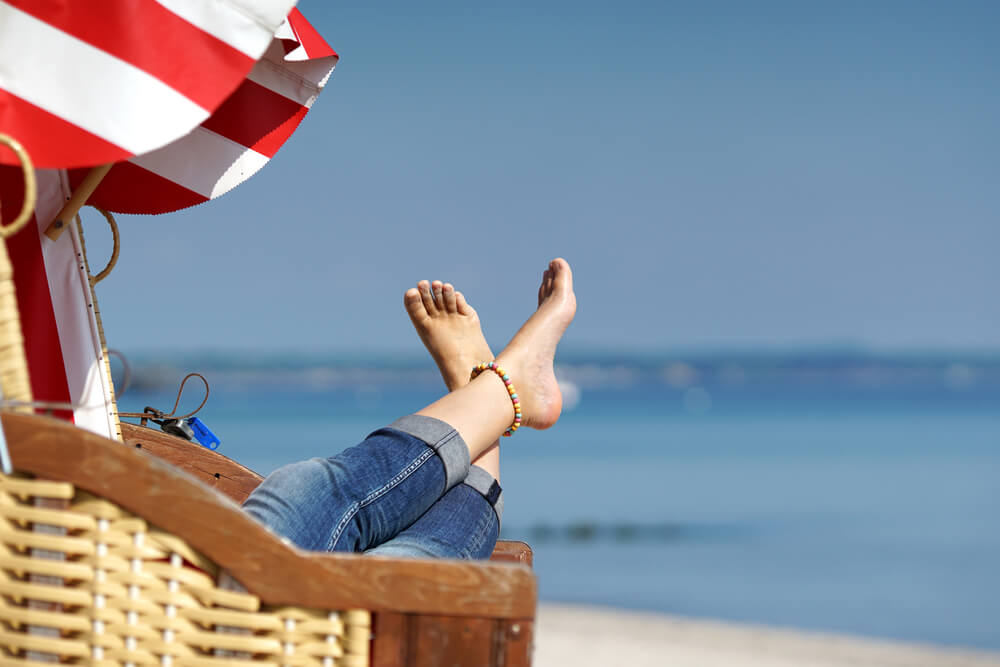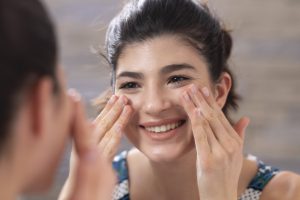Vacation time is here and we are enjoying the beautiful time outdoors and in the sun. Sunbathing and walking barefoot in the summer sun is balm for the soul.
Despite sun protection, it’s easy for our skin to get a little too much sun and the result, depending on the skin type: sunburn. What to do then, the first steps for quick help for sun-damaged skin can be found here.
What actually is sunburn?
The medical term for this is dermatitis solaris. The name describes the problem very well: an inflammation of the skin caused by the sun. In the case of sunburn, UV rays penetrate the skin and destroy protein and fat structures, as well as the DNA of the skin cells.
The damage to the lipid structures mainly affects the outermost layer of the skin (also known as the horny cell layer), where the lipids form a water-repellent protective layer with the horny cells. Damage to these compounds leads to a disruption of the natural skin barrier. The consequences include increased moisture loss and the skin dries out more quickly. This can also have other consequences for the skin, such as faster ageing, age or pigmentation spots or reduced skin elasticity.
Bacteria or germs can penetrate the skin more easily in these conditions. The result is an increased risk of infection. The body naturally tries to repair the damage and reacts with an inflammatory reaction. Vessels are dilated (redness becomes visible) and tissue water accumulates (edema) with the corresponding swelling. The DNA damage mentioned also affects the cell’s own ability to regenerate. As a result, cells are often no longer viable or die. This is very often visible through peeling of the skin.
Feet are often hit particularly hard. This is often the case regardless of skin type, as the sensitive skin on the feet is generally not used to the sun’s rays and has little protection of its own. However, the feet are often simply forgotten when applying sunscreen and the consequences can be serious.
Quick help is needed for sun-damaged skin!
Sun exposure is generally a burden for the skin. Once the sunburn is there, home remedies are quickly resorted to, but what does the expert recommend?
First step
If it is already too late, the sun-damaged skin should be cooled. It is important not to use ice or similar, but ideally simply cool tap water. This directly relieves the pain and reduces the temperature of the overheated skin. In addition, the blood vessels become narrower again and the redness of the skin is reduced. Cooling also prevents the formation of further swelling or reduces swelling that has already occurred.
Second step
Follow with intensive care, i.e. always use highly moisturizing gels or care products to stabilize the horny layer and the natural barrier function. Very greasy care products should be avoided, however, as these have a skin-sealing effect and can hinder the release of heat or increase the inflammatory reaction.
Ideally, oil-in-water emulsions with a high water content should be used. They cool the skin through evaporation and support the restoration of the natural skin barrier through the fats they contain. Products such as Spirularin HF Gel with the microalgae active ingredient spiralin have a soothing, anti-inflammatory effect2 3 and regenerate UV-damaged skin cells1 and provide the skin with ingredients such as glycerine and coconut oil with sufficient moisture.
Third step
Make sure you eat the right foods. Vitamin A, vitamin C, vitamin E as well as minerals and flavones protect against free radicals and can also have a positive effect on the skin. As can drinking enough water on warm summer days.4
Conclusion
Enjoy the sun, but with caution. And always remember to use products with a sufficient sun protection factor to prevent the next sunburn. Don’t forget the sensitive skin on your feet and face! And if things do go wrong, don’t forget our expert tips!
1 Prof. Dr. Dr. h.c. Otto Pulz, Potsdam: OM & Nutrition, European Journal of Orthomolecular and Related Medicine, No. 131, 09/2010
2 Prof. Dr. med. Kristian Reich: Cosmetic Medicine, Volume 32, 2011, Issue 2.11
3 Aesthetic Dermatology, Volume 2013, Issue 6 / 13, Product of the Year 2013
4 In collaboration with Anke Niederau, podiatrist, taken from her article “Summer, sun, protection”
Image source: Jenny Sturm / shutterstock.com
Experten-Tipp entstand in Zusammenarbeit mit:
Patrick Günther
Patrick Günther completed his pharmacy studies in Hamburg and, after obtaining his licence to practise, worked for several years in marketing and sales in the pharmaceutical industry. In 2003, he took over ocean pharma, the company founded by his father in Reinbek near Hamburg in 1978. Together with his business partner, he patented the important processing and standardisation process for the microalgae active ingredient Spiralin® and developed a wide range of medical cosmetics and foot care products based on Spiralin®.







